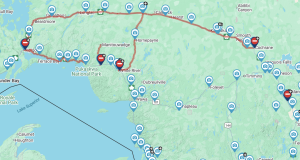The strong partnership between Northern Policy Institute and the Northern Ontario chamber network was on full display in Timmins last week.
The 2024 Ontario Chamber of Commerce (OCC) Annual General Meeting & Convention took place in Timmins on April 25-27. During that gathering, the Thunder Bay Chamber of Commerce submitted two resolutions for consideration by OCC membership. Both resolutions were backed by Northern Policy Institute (NPI) research. Both resolutions passed, one of them unanimously.
“Access to high quality research from Northern Policy Institute makes our work advocating for Northern Ontario businesses that much easier”, said Thunder Bay Chamber President Charla Robinson. “Good data and a strong northern chamber network give the OCC confidence in backing the ideas we put forward to strengthen rural and northern communities.”
The first resolution promotes moving away from highway twinning by the province and moving to the wide adoption of the 2+1 model for northern and rural highways. According to Charles Cirtwill President and CEO of Northern Policy Institute this would allow more rapid replacement of our old and dangerous two-lane system. “If we continue to wait for twinned highways, it will be another generation, or two, before Northern Ontario is served by a safe, high-capacity road network worthy to be called a national highway.”
The Going the Extra Mile for Safety Committee of the Temiskaming Shores & Area Chamber of Commerce has been exploring global experience with the 2+1 highway model since 2015. As a result of those efforts, the province announced in 2021 they would launch a pilot project to test the model in northeastern Ontario. Recent work by Northern Policy Institute concluded that given the similar safety records and capacity of 2+1 and twinned highways, and the significant cost and time savings of the 2+1 approach, the province (with federal support) should move to much more rapid expansion of the major highways in Northern Ontario to 2+1 within the next decade.
The second resolution endorsed by the OCC membership dealt with a set-aside of 3,000 spots in the Ontario Immigrant Nominee Program (OINP) for northern Ontario and a further 6,000 spots dedicated to rural communities in southern Ontario. Says Cirtwill, “Our research highlights that Northern Ontario needs to welcome upwards of 5,000 new immigrants every year for the next twenty years to deal with population aging and a growing skills shortage. We won’t get there without dedicated allocations of available immigration streams.”
SOURCE: Northern Policy Institute
- Ladies Curling Standings – December 18th - December 18, 2025
- Robinson Huron Waawiindamaagewin hosted The (Un)Making of Métis Claims in Ontario - December 17, 2025
- Confederation College Launches Canerector Foundation Scholars Program to Support Skilled Trades Students - December 17, 2025
 Wawa-news.com You can't hear the 'big picture'!
Wawa-news.com You can't hear the 'big picture'!

